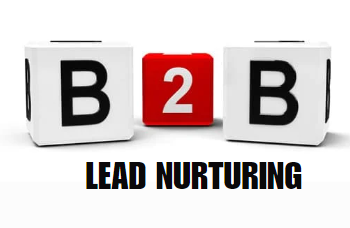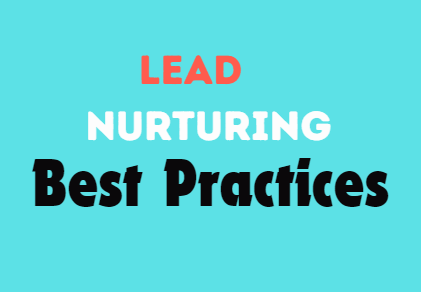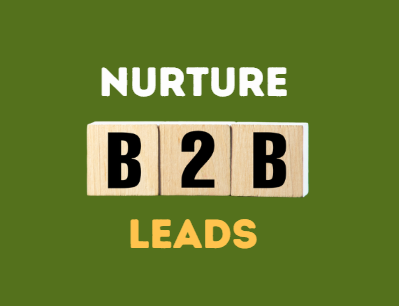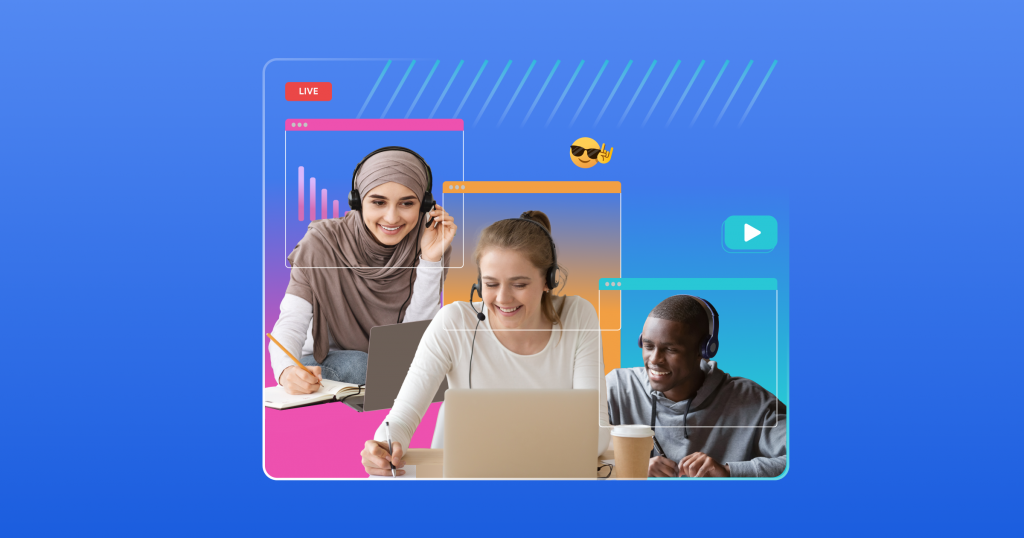A lead that is generated from your B2B event, such as a webinar, doesn’t automatically guarantee a conversion. You will have to follow up with them after the webinar and nurture them effectively and carefully, to convert them into customers.
For that, you need to develop a powerful lead nurturing strategy that won’t only keep the leads engaged but also transform them into loyal, paying customers.
In this guide, we will learn how to nurture B2B leads after the event wraps up.
According to this stat, companies with a good lead nurturing program generate 50% more sales-ready leads at 33% lower cost
What is B2B Lead Nurturing?

B2B lead nurturing is the process of maintaining a sustained relationship with prospects in order to guide them through the buyer’s journey and eventually convert them into customers. Lead nurturing is a great opportunity for enterprises to provide value to their potential leads, earn their trust, and offer unique customized experiences.
Based on this stat, nurtured leads make 47% larger purchases than non-nurtured leads. Not all your prospects are ready to make purchases and become your clients. At such times, creating a lead nurturing campaign will play a vital role in building rapport with leads, and guiding them toward making a purchase.
Lead nurturing is often done through effective content sharing, sending personalized emails, providing valuable resources, and offering tailored recommendations. By delivering personalized content and providing useful information, businesses won’t only educate leads but also gradually move them closer to investing in their offerings.
Best Practices for Nurturing B2B Leads Post the Webinar

Lead nurturing is not just about marketing; it is about your product or services, your audience, and a combination of everything you do to cultivate connections with prospective clients. However, carrying out a lead nurturing program to success is not easy. It requires careful planning and execution to achieve your marketing and sales goals.
Here are some best practices that will make your lead nurturing campaign super effective:
- Segment Your Leads: Lead segmentation is crucial in marketing, especially for B2B marketers and sales professionals. It is the process of separating your prospects into groups based on characteristics, such as demographics, behaviors, and preferences.
According to this report, 62% of marketers found that lead segmentation improved response rates. It allows you to divide your leads into smaller & more targeted groups so you can tailor your messaging and deliver more relevant content to each segment, increasing the chances of conversion.
To segment your event leads effectively, first, divide your leads generated into two groups: those who attended the event and those who registered but didn’t attend. This segmentation will help you create different follow-up strategies. For example, to those who attended the event, you’d send a thank-you email with the event recording and additional content relevant to their interests, and to non-attendees you’d send only the session recording.
Also, classify leads based on engagement which is important in identifying highly engaged leads. Use analytics to understand who interacted more actively during the event, asked more questions, participated in polls, etc. These leads are sales-ready so accordingly you will prioritize them.
- Send a Timely Follow-Up Email: After segmenting leads, send a follow-up email to all webinar attendees within a day or two. According to this stat, 42% of people are more likely to buy when they get timely follow-ups and first follow-up mail increases the reply rate by 49%.
Following up not only allows you to build a positive relationship with potential buyers but also encourages them to take the next step.
In webinars, you engage leads by effectively informing them about your brand, offerings, products, or services. Your timely follow-up will help you maintain the same relationship and engagement with the buyers you had at the event.
- Offer Educational Content: After the event, provide prospective buyers with valuable content, reference materials, or resources to boost further engagement and nurture those leads effectively. Leads who attend a webinar are likely to be more interested in your offerings. Providing them with something that creates value, can nudge them towards taking positive action.
Share the recording of the session, as well as the highlights from the webinar. Offer whitepapers or ebooks that delve deeper into the topics discussed in the webinar.
Additionally, you can also share relevant case studies that show how your product or service has helped other businesses solve their problems.
Offering educational content like this can help address the common pain points your target audience faces. It will also show that you care about their needs and establish yourself as an invaluable resource for them.
- Connect on LinkedIn: LinkedIn is a powerful platform for connecting with B2B customers. According to the LinkedIn stat, 35% of B2B marketers ranked LinkedIn as the most important social media network overall in 2021.
It is a great place to get B2B clients organically, as it allows you to introduce your business to your target audience, engage with them by sharing relevant posts, and build relationships that can drive sales.
This report shows that compared to other social channels, 82% of B2B marketers obtain their greatest success with LinkedIn Since it attracts a large audience of decision-makers and industry professionals. And, more than 80% of B2B leads on social media are from LinkedIn.
Yes, you will send out follow-up emails after the webinar to effectively nurture all B2B leads but that’s not enough. Engaging with leads across multiple channels, especially on LinkedIn can increase your chances of building a good relationship with clients more.
- Leverage Retargeting Ads: This is another way to reconnect with leads who have expressed interest in your business. In the B2B world, retargeting is particularly effective for nurturing leads and driving conversions. It helps you to continue your engagement with prospects and keep your offerings at the top of their minds.
With retargeting ads, you can tailor your ad campaign based on actions customers have taken, such as visiting a particular product page, downloading a whitepaper and case studies, or attending a webinar.
For retargeting, leverage as many social media channels as possible: Facebook, LinkedIn, Google, Twitter, and YouTube as they are primary channels for retargeting. Ensure creating a series of ads to reinforce your brand’s message effectively and gradually move leads down the funnel.
- Hold a Follow-up Webinar: Holding a follow-up webinar is a fantastic idea to nurture B2B prospects, deepen engagement with them, and increase the likelihood of conversion. It gives you an opportunity to voice their concerns or queries and simultaneously provide them with a solution, keeping the lead actively engaged with your brand.
Invite leads who showed interest in your offerings and schedule a live Q&A session to meet their requirements. You can include a live demo of your product or services to give attendees a hands-on experience in real-time and understand its features firsthand.
Live demonstrations often make people connect with your brand. Just ensure that you have practiced the demo beforehand so that you can deliver a smooth, engaging, and informative presentation.
- Schedule a Personalized Sales Call: Getting your sales team to schedule personalized calls with warm event-generated prospects can be a great way to close the deal.
A one-on-one call can help understand their specific requirements in more detail. Your sales team can ask them direct questions to better understand their pain points and explain how your solution will address their unique challenges.
Additionally, a direct call can create an opportunity for upselling, allowing the sales team to promote other products or services you provide.
What are the Core Benefits of Nurturing B2B Leads?

B2B lead nurturing is a critical component of a successful sales strategy. It not only converts more leads into paying customers but also strengthens the overall sales pipeline.
According to this stat, over 35% of B2B marketers have implemented a lead nurturing strategy. Because they know it can significantly boost conversion rate and overall sales performance.
Let’s look at some of the key benefits that B2B lead nurturing brings to businesses:
- Boosts Conversion: A lead nurturing strategy allows you to provide personalized, and relevant content that addresses clients’ needs and effectively engages prospects throughout the sales funnel, thereby increasing the conversion rate.
- Shortens Sales Cycle: Lead nurturing not only helps you convey product-related information to prospects but also demonstrates the company’s culture and values. By gaining the trust of customers, it prepares them to make a purchase which shortens the sales cycle.
- Identifies Buyer Needs: Through personalized communication and tailored messaging, you can understand your customer’s specific interests and pain points.
For example, if a lead downloads a white paper on a specific topic, you can immediately send a tailored follow-up email with a case study or other relevant resources.
This targeted approach will improve lead nurturing efforts, moving leads towards becoming your customer.
- Enhanced Lead Quality: Nurturing helps you identify high-quality leads. It lets you know who is truly interested in buying your products or services, ensuring that the sales team focuses on the most likely prospects to become customers.
- Reduced Customer Acquisition Costs: Nurturing current leads is considerably less expensive than acquiring new ones. By investing time and resources into nurturing your pipeline, you can reduce your overall customer acquisition costs and improve your return on investment.
- Enhanced Brand Reputation: A well-executed lead nurturing program builds a positive brand reputation. Offering valuable resources and excellent customer service, you demonstrate your expertise and position your business as a thought leader in your industry.
Conclusion
B2B lead nurturing is all about forming a connection and building trust in potential customers so they choose your business to solve their problems. The purpose is clear and simple – guide prospects and buyers through the sales funnel and turn them into paying customers.
Lead nurturing process not only allows you to listen to customers’ needs during their buying journey but also helps anticipate needs and guide them toward purchase. It is a crucial part of post-event webinar strategies. In the B2B landscape, a well-structured post-webinar plan can significantly enhance the lead nurturing program.
From segmenting leads to sending follow-up emails and offering educational content to leveraging retargeting ads, each approach will play a vital role in nurturing B2B leads and driving conversions in your sales funnel.
FAQ
Post-webinar strategies allow you to follow up with potential leads, guide them through the sales funnel, and boost business sales. It also helps build a stronger bond with your prospects, gather their valuable insights, and address any questions or concerns that attendees may have.
Essential elements include audience segmentation which allows you to divide lead groups, outreach campaigns such as email, social media, etc. that enable you to engage with leads across platforms, educational content like whitepaper or case studies that guide leads toward making informed decisions, automation tools that help deliver timely messages and follow-ups to keep leads remain engaged until they are ready to buy your product or service.
Nurturing B2B leads effectively requires creating informative, relevant, and valuable content. Educational resources such as whitepapers, case studies, ebooks, webinars, blog posts, and email newsletters can best attract and nurture prospective leads through the sales cycle.
- Segmentation: The first step is to segment leads into groups based on their industry type, company size, and more.
- Educating Leads: Next, it is to educate leads through various resources, such as webinars, eBooks, whitepapers, and blog posts.
- Nurturing Relationships: The next stage is to deliver tailored content, communicate regularly, and guide prospects through the sales funnel.
- Closing: The final stage is converting qualified leads into customers through effective sales follow-up and negotiation skills.

































